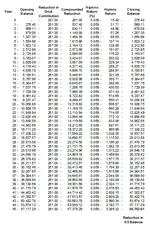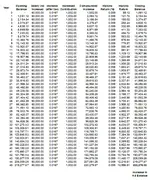All the discussion around the changes to the government contributions to KiwiSaver effecting the balance of a person retiring is based on the figure of $60,000 that Hipkins made yesterday. So, how did he arrive at $60,000 reduction in a young person starting out in KS when, assuming they would have been contributing for 45 years (aged 20-65), the amount of government contributions over those 45 years would be only $11,700 ($260 x 45 years)?
But, those saying he got it wrong are forgetting that the contribution amount not paid by the government would have compounded. Using the spreadsheet below, Hipkins (or someone advising him) used a compounding interest rate of just under 6%.
View attachment 13110
However, Hipkins failed to take into account (or, completely ignored it as it doesn't help his narrative) the impact that the increases of the employer and employee contributions would have for those working. The increase each year compounds by 1.67% (remembering that the 1% employer increase is taxed) and that has a dramatic effect on the final KiwiSaver balance. The same young worker entering into the workforce that Hipkins spoke of and earning the same compounding interest rate would be $172,000 better off if they started on $60,000 PA and never received a salary increase over the next 45 years than what their current KS balance would have been without ALL the changes announced yesterday. And, if that young person average a 1% annual increase in salary over their 45 years working, they would retire on $207,000 in additional retirement savings.
Actually, these figures would be even higher as I've only compounded it annually when being paid weekly, fortnightly or monthly adds far more on to the final increase in KS balances.
View attachment 13111 View attachment 13112
It all depends on the narrative you want to use and if you forget about how compounding the reduction in government contributions effects a KS balance or how adding compounded interest on the changes to the employee and employer contributions effects a KS balance. Oh, the games politicians (and the media) play!!!



